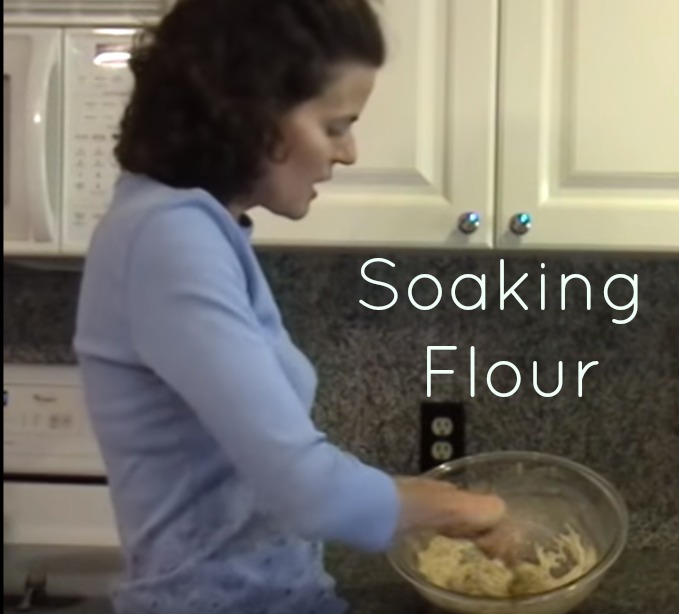Table of Contents[Hide][Show]
Soaking flour for maximum digestibility is one of the three traditional methods of grain preparation for healthy, nutritious bread as practiced by Ancestral cultures.
One of the most important baking techniques to learn when implementing a traditional diet is soaked flour. This ancestral method of grain preparation enhances digestibility and improves the metabolism of nutrients.
This technique also reduces anti-nutrients such as phytic acid in the grain flour. These substances block mineral absorption and can aggravate inflammation of the intestinal tract. Gluten-free grains also contain these anti-nutrients.
Other methods for reducing anti-nutrients in grains and improving metabolism include sour leavening (sourdough) and sprouting.
How to Soak Flour
Soaking flour is simple. Simply mix grain flour with yogurt, kefir, or clabbered milk, cover with a dishtowel, and let sit on the counter overnight. Freshly ground flour produces the best results. After the allotted soaking time, blend in the remaining ingredients and bake or cook as usual.
Non-grain based flours such as cassava and coconut flour do not need soaking. Others such as almond flour and chickpea flour are best soaked before grinding rather than after.
Dairy-Free
For those with milk allergies, substitute 1 cup of filtered water per cup of flour plus 2 TBL of lemon juice or apple cider vinegar and soak as usual for at least 8 hours or overnight.
For those with more extreme wheat sensitivities, the soaking time can be increased up to 24 hours to further breakdown gluten and other anti-nutrients.
Soaking any longer than 24 hours risks the development of mold.
Soaking Flour Technique Applies to All Grains
The principle of soaking can be applied to whole grains as well, such as your morning oatmeal. It was common to soak oats overnight before cooking back before WWII. This step was apparently even suggested on the Quaker oatmeal box!
It seems with the modern preference for speed in food preparation, this essential step has been lost. Hardly anyone under the age of 80 even remembers it anymore.
Try soaking your oatmeal the night before and see how much more filling it is after you cook and eat it the next morning.
Instead of being hungry again at 10 am, you will likely be full right through until lunch! To soak oatmeal, use 1 cup of warm filtered water per cup of oats plus 2 TBL whey, yogurt, kefir, or buttermilk. Stir together in the pot you will cook them in, cover with the lid, and leave overnight.
Cook, as usual, the next morning.
Bread Recipes Using Soaked Flour
Try this soaked bread recipe with your soaked flour. You can also try making a soaked loaf in a bread machine.
The video in the recipe tutorial below demonstrates visually the simple process of soaking flour. Try it with your next flour-based recipe!

How to Soak Flour
How to soak flour of all kinds before making the batter to improve digestibility and nutritional benefits of bread and other baked goods.
Ingredients
- 2 cups flour preferably freshly ground and organic
- 2 cups whole milk yogurt
Instructions
-
Mix flour and yogurt in a large bowl.
-
Cover with a clean dishcloth and secure with a large rubber band.
-
Leave on the counter overnight or for 8 hours.
-
Uncover, mix in remaining ingredients for whatever recipe you wish to make and bake as usual.
Recipe Video
Recipe Notes
Clabbered milk or plain kefir may be substituted for yogurt.
If there is a dairy allergy, 2 cups of water plus 2 Tbl lemon juice may be substituted. This reduces the calories to 910 for one batch.








Hi Christy, if it doesn’t have any mold on it, then you can probably take off the hard crust that has probably formed on top and go ahead and make pancakes anyway. They might be kind of sour though. Not sure as I haven’t ever left soaking flour for that long before.
Can you over soak wheat? I started soaking some wheat about 3 days ago in the water and whey and was unable to make anything with it until now. Is it still okay to use it to make pancakes?
Thank you, my first soaked pancakes were a success!
Hi Christy, if its too soupy, add some more flour to get the right consistency and keep soaking for the rest of the 24 hour period.
I grinded my on organic soft white wheat and then soaked it using the water and apple cider vinegar. It soaked for about 15 hours and was still really runny. Is this still good to use? Or did something go wrong?
Actually I just found a site that informs us that only unhulled oats can be sprouted, that hulled oats will not sprout. It sure would be nice to be able to do it myself, but not sure how to get the groats hulled after dehydration. Anyone?
Naomi
I've only ever soaked rolled oats like for traditional oatmeal. Not sure about steel cut oats. They might be best for grinding into oat flour and then soaking.
I tried soaking steel cut oats, and even after a couple days the oats were still hard, and cooking didn't soften them either. Is there a different way to preparing them properly?
Thanks!!
Sorry, I meant also to ask you, have you ever sprouted oat groats and dried and rolled them for cooking/baking? Do you have any info about that?
I have been sprouting my own wheat for about a month now, dehydrating it, and grinding into flour to make bread in my bread machine. I want to tell you, it is fabulous! For those of you who want a good sandwich bread that is soft and squishy, yet is sturdy enough to make a sandwich that is filling and satisfying, I have a recipe that works, and I use my sprouted wheat flour in this recipe. It is called Marilyn's Famous Whole Wheat Bread, and she gives versions for making it in a mixer and baking in your oven and also for making in a bread machine. I don't use a Zojirushi bread machine like she does, just a standard one with a whole grain setting. You can find the recipe at her website, UrbanHomemaker dot com/index.php?article=83. Where she calls for dough enhancer, I use diastatic malt that I made myself by sprouting wheat until it had 1/4" sprouts, dehydrating, and grinding into powder/flour. You only need a very small amount per loaf, and it makes an amazing difference in the texture of the loaf. The recipe also calls for vital wheat gluten, which I use.
Which brings me to my question: Is vital wheat gluten something we should be using or not? I don't see any references to it in NT book. I'd appreciate any information you can provide.